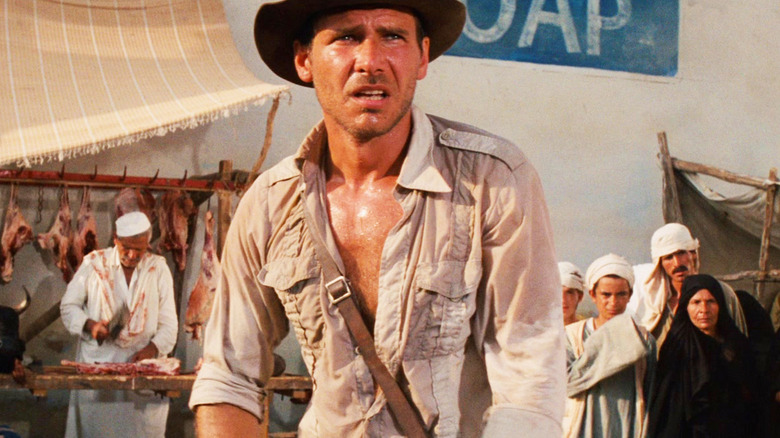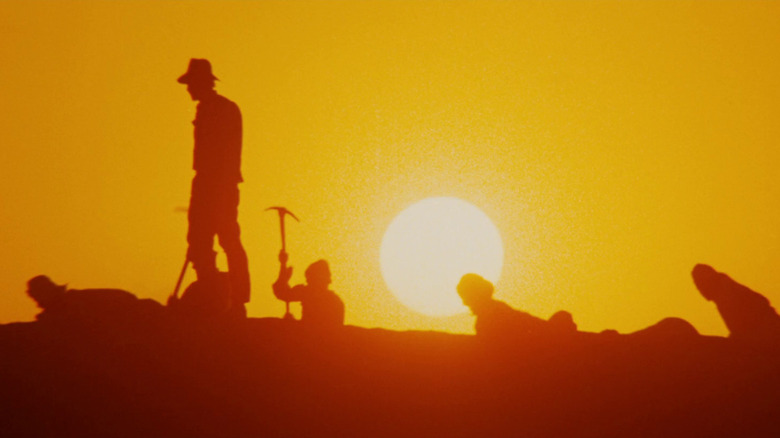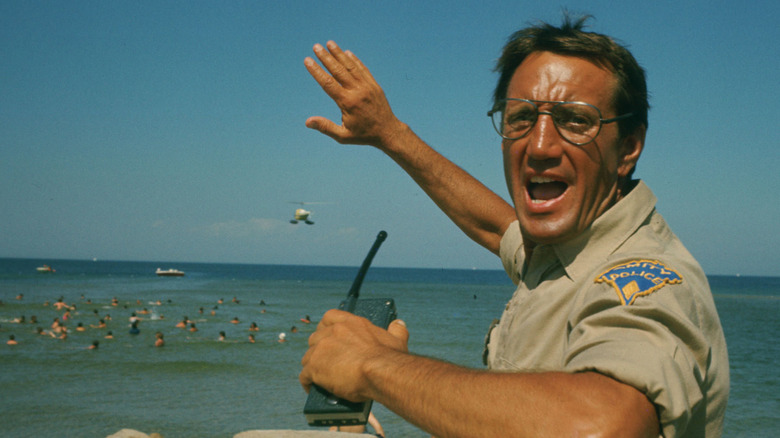Raiders Of The Lost Ark Countered Jaws In Taking Advantage Of An Underrated Effect
He's one of the greatest, most successful filmmakers in the history of the moving image, but there were times throughout his career when even Steven Spielberg needed a hit. Badly.
One such crucial juncture arrived in 1980. After the unprecedented blockbuster combo of "Jaws" and "Close Encounters of the Third Kind," Spielberg face-planted with the critically reviled World War II comedy "1941." Turns out a lot of folks thought making hay out of the Pacific Coast's gun-toting freakout in the immediate wake of Pearl Harbor was in poor taste. In any event, though the film was a moderate box office hit, it was perceived as a full-scale fiasco for the Hollywood wunderkind. Had success spoiled Steven Spielberg?
Spielberg not only felt the heat, he thought he'd barely escaped disaster with his two smashes. He'd come close to getting fired when "Jaws" went way over schedule (as he scrambled to shoot around a malfunctioning mechanical shark), while he (and producer Julia Phillips) got Columbia Pictures to greenlight "Close Encounters" on a $2.7 million budget that ultimately ballooned to $19.4 million.
After the $35 million bloat of "1941," Spielberg had good reason to believe he was one mega-budget flop away from director jail. The next film had to be made responsibly, and it probably wouldn't hurt if he reestablished his dreamweaver credentials with the moviegoing public.
So when he agreed to make "Raiders of the Lost Ark" with his buddy George Lucas, he resolved to be over-prepared this time. We know he delivered the goods, but did he deliver them in a fiscally responsible manner?
The sun is the cinematographer's friend (unless that cinematographer is Vilmos Zsigmond)
If you've never read Steven Spielberg's 1981 American Cinematographer essay on the making of "Raiders of the Lost Ark," you need to remedy that posthaste. It is a fascinatingly detailed recounting of every creative and logistical decision he made to ensure that he wouldn't go soaring over budget for once. This meant storyboarding more than he was used to, and using a second-unit director for the first time in his career (primarily to bring the film's bruisingly brilliant truck chase in on schedule). It is an insanely lengthy piece for a filmmaker of his stature and talent to write for a specialty publication, so savor every word.
One of many valuable insights in the essay is a paragraph praising cinematographer Douglas Slocombe's use of the sun. He marvels how the chameleon-like Slocombe's love of the orb contrasts with a stylist like Vilmos Zsigmond's hatred of it (while shooting "The Sugarland Express," Zsigmond insisted on waiting for clouds to block it out).
But in terms of preparation, Spielberg's most revealing observation is how, while shooting "Jaws" on open water, he never gave a second thought to the position of the sun. As he wrote in American Cinematographer:
"On 'Jaws,' the sun was the most taken-for-granted issue. It was always out and we didn't care whether it was front, side or back, as long as the shark worked. So, really, for the first time, I became aware of how the sun could be used as a tool of great artistry and I think Slocombe used the sun on 'Raiders' the way Vittorio Storaro [ASC, AIC] uses his amber smokey units inside to such great effect."
The sun will never set on Spielberg's cinematic empire
This is especially interesting to consider 42 years later now that Spielberg has essentially made cinematographer Janusz Kamiński the visual co-author of his movies. Sunlight in Kamiński-shot Spielberg films can be blinding, streaming in through drapes and bathing characters in its incandescent power. It can be a joyous sight (as in the most ebullient moments of "West Sight Story") or full of dread (see "A.I. Artificial Intelligence"). Regardless, it's a sharp departure from the classical look of Slocombe's three Indiana Jones movies (one that became particularly pronounced when Kamiński tried to incorporate the British DP's style into "Indiana Jones and the Kingdom of the Crystal Skull").
In that American Cinematographer article, Spielberg says that his favorite type of lenser is one whose style is unidentifiable. Without credits, I can spot a Kamiński-shot movie within minutes. This isn't a criticism. I think Spielberg has made multiple masterpieces with the man. It's just interesting to see how he's tweaked his aesthetic over the years. And how he's been able to remain one of our most visually inventive directors while bringing each film in, with a few notable exceptions, on time and on budget.


